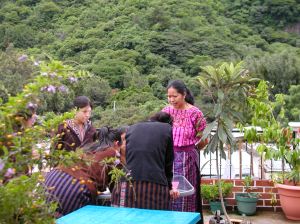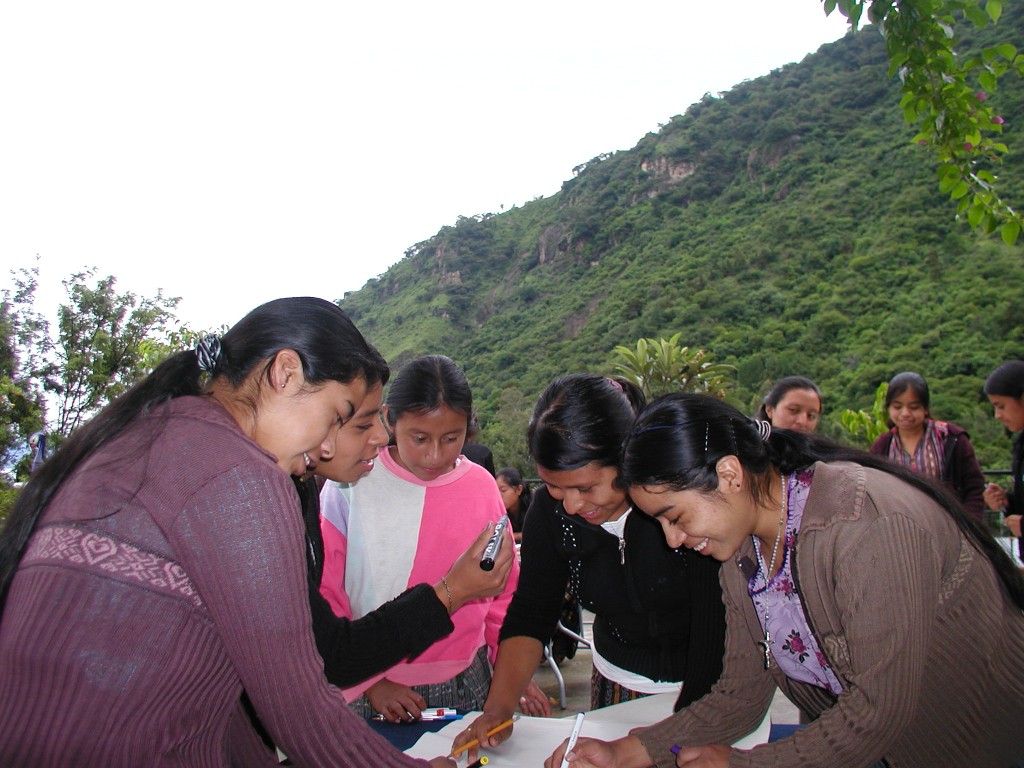Half the Sky, by Nicholas Kristof and Sheryl WuDunn, has been very inspirational reading for me. It demonstrates the creativity people use to make ends meet when given a leg up via a small business loan or scholarship.
Prior to our trip to Guatemala, I learned of an organization called Starfish One By One–now called Maia Impact–located in that country which would make Kristof and his wife smile. As they mention in Half the Sky, much research indicates that putting money toward educating and supporting women is the most efficient way to raise communities out of poverty. This is just what Maia Impact is doing in Guatemala.
After hearing about Maia Impact, Annie, Daniel, and Stephen decided to collect school supplies for this program before we left for Guatemala. We would be there for almost a month learning Spanish and could deliver the supplies in person!
The non-profit told us they were in need of computer flash drives, calculators, digital cameras, and large world maps, among other things. These wouldn’t have been at the top of our list. Glad we contacted them!
Next, our kids informed their classmates about our collection plans. Many families were wonderfully generous, and soon we’d filled an extra suitcase with school supplies. Did you know that if you bring a suitcase of donated supplies, the airlines don’t require a luggage fee? I just learned this recently (about 7 months too late), but maybe this information will help one of you!
That summer, after our Spanish school had ended, our family traveled by van, along many mudslide-induced detours, to the Lake Atitlan area of Guatemala to visit the Maia Impact program.
Maia Impact pays poor Mayan girls to stay in school through 12th grade. The majority of these girls in Guatemala drop out of school after 6th grade because they need to earn money for their families. Maia Impact also gives students a local mentor to support them throughout their schooling since few young women take this educational route. The Maia Impact students meet as a group each Sunday morning for a life skills lesson, and also as a means of support.
When we visited the Maia Impact program one Sunday morning in July, we were somewhat exhausted by many aspects of our Guatemalan experience (see previous post). It didn’t help that our taxi driver had gotten lost and dropped us off far from our destination.
When we eventually found the correct address, we were facing a nondescript, gray, cement block building which houses Maia Impact. Our family was welcomed in and led up a central staircase with photos of smiling Mayan girls and their artwork hanging on the walls. 
At the top of the stairs was a covered balcony room with a panoramic view of the city and surrounding mountains. There, a group of seventeen Mayan girls was being taught by one very energetic Mayan teacher, Candelaria.
Candalaria knew beforehand we were coming. We gave the girls the school supplies we’d collected and they thanked us in excited voices. The girls were dressed in beautiful woven tops and skirts, the patterns and colors of which indicated the Guatemalan region in which they lived. They were fifteen and sixteen year-olds who had been with Maya Impact for a few years already.
Candelaria had a small, red and yellow hacky sack ball which the girls tossed from person to person. The catcher had to introduce herself. Each student told us her name, the pueblo she was from, and how far she traveled to get to the city of Panajachel where the Maia Impact meeting was held at 8am each Sunday.
At the end of her introduction each girl said, (in Spanish) “After graduating, my dream is to be a…” Many said they wanted to be teachers, two wanted to be doctors, one wanted to be an accountant, others wanted to own a business. The girls were so sweet and hopeful when revealing their dreams to us.
Next, we introduced ourselves. Stephen and Daniel told the girls in Spanish what their goals were after graduation. Annie told them too, with our help. I shared that I was a psychologist, but I’d finished my schooling before I’d had the kids. I told them that for me it was so much easier to have completed my education in this way. Candelaria’s face lit up when I said this, as waiting to have children is part of what Maia Impact aims for with their students.
The day we visited Maia Impact, Candelaria was teaching the girls how to start a small business. She didn’t assume that they’d all choose this as a career, but she wanted them to have this skill along the way to their long-term goal. She instructed the students about the importance of saving a little money every time they were paid. She mentioned to Todd and me that the girls are from very poor families which are always facing one hardship or another. Therefore, the skill of saving is never taught to them.
During this lesson Daniel and Stephen told the girls that they had a small business at home where they shovel snow, rake leaves, and take care of pets when neighbors travel. The girls were quite surprised that American kids would work for money. Then we talked about what percentage of money Stephen and Daniel save each time they are paid. Candelaria highlighted this comment because she was about to teach the girls percentages as part of this class.
Later Candelaria proudly told us what some of her students had accomplished. One girl, Marina, was the first in her pueblo to become a teacher, ever. Marina was about to graduate. She pointed out Marina’s town high atop a misty, forested mountain and said that to get home, Marina took the bus for an hour then walked a steep trail though the thick woods for thirty minutes.
We also heard about two girls who usually take the bus to Maia Impact meetings, but recently their road had been washed out. For the past month they’d hiked up and over a mountain path to get to the Sunday meetings.
The girls then broke into small groups, drew maps of their towns, and noted the small businesses already in existence. After this lesson we said goodbye to the girls and headed downstairs. On the bottom floor we were briefly introduced to a group of 15 twelve and thirteen year-old girls. These students were in their first year of Maia Impact. They looked so young, it was hard to believe this was the age that most Mayan girls dropped out of school.
On our way out, we met a table full of boys of varied ages, one of the only boy groups in Maia Impact. Candelaria also told the boys about Stephen and Daniel’s neighborhood services business. These boys had been learning about the importance of saving money regularly too from their teacher, Candelaria’s husband Gregorio, another mentor in the Maia Impact program.
I’m trying to put my finger on why I found Maia Impact so inspiring. I think it was because it confirmed the research I’d read in books like Half the Sky. Focus on educating girls, and they will then pass along their increased resources to their communities. Additionally when Maia Impact takes on a student, it supports her to the end of 12th grade, through all the crises she encounters along the way. Sitting with the girls that morning, I saw how much having Candelaria as a mentor, a woman from their own community, was a key to the success of this program. Candelaria was clearly like a second mother to the girls. She took them seriously, and they in turn took themselves and their schooling seriously.
I thought of our time at Maia Impact again one early morning as our family canoed on Lake Atitlan, which was peaceful and placid that day. I shared a canoe with twelve year-old Stephen, and as we paddled we came across groups of young Mayan women doing laundry along the shore. They stood in the water, with their long, bright-colored skirts knotted above their knees, and scrubbed items of clothing.
As we canoed along the shore for probably two miles, we must have seen ten groups of women and girls washing. Most of them looked quite young, perhaps between twelve and eighteen. Stephen and I talked about the fact that if his female classmates in Colorado had been born here in Guatemala, we’d be seeing them washing clothes with their older sisters and mothers on this day.
I think this real-life comparison made an impression on Stephen. It definitely made one on me.
I’d love to hear about additional non-profits doing needed work like this. Leave a comment!


 Sweet Spots: Helping Your Kids Find ENOUGH in Their Lives.
Sweet Spots: Helping Your Kids Find ENOUGH in Their Lives.


Suzita,
I finally had time to read this post…it is LOVELY. What a wonderful story and experience all the way around. I love the informal cultural exchange that happened between your family and the girls at the Starfish program–your boys talking about their business, and saving money, and the girls talking about their dreams for their futures. It’s another reminder of the fact that sometimes change happens on a very “micro” scale–in this case, in the form of a conversation between children. Love it!–Catie
Thanks for this nice comment! Whenever we do an off-the-beaten-track trip like the one to Guatemala, I always know we will have unexpected “gem” experiences. I just never know what they’ll be ahead of time. The time we spent with this program was such a highpoint in this way. I’m glad I was able to portray this in my post.
So love educating the girls in Guatemala. I do same, but concentrate mainly on supplying critical needs for their mothers. So hard to be a good mom without shelter, nutrition, water, etc. Thank you for showcasing the need.